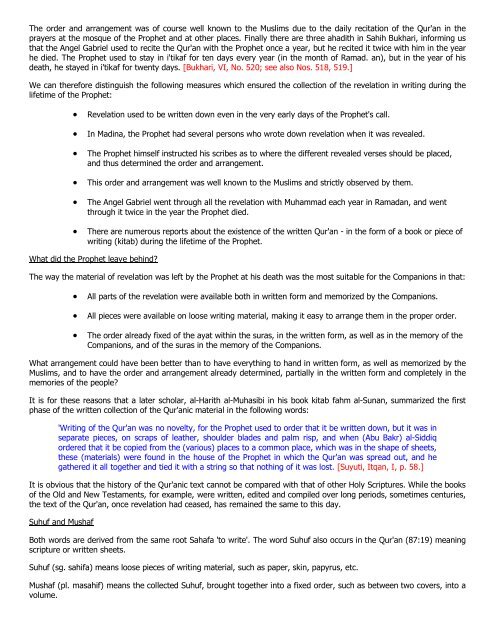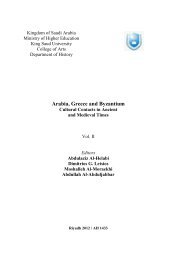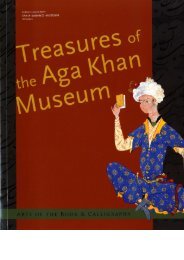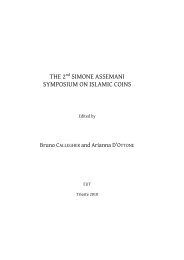ulum-al-quran
ulum-al-quran
ulum-al-quran
You also want an ePaper? Increase the reach of your titles
YUMPU automatically turns print PDFs into web optimized ePapers that Google loves.
The order and arrangement was of course well known to the Muslims due to the daily recitation of the Qur'an in the<br />
prayers at the mosque of the Prophet and at other places. Fin<strong>al</strong>ly there are three ahadith in Sahih Bukhari, informing us<br />
that the Angel Gabriel used to recite the Qur'an with the Prophet once a year, but he recited it twice with him in the year<br />
he died. The Prophet used to stay in i'tikaf for ten days every year (in the month of Ramad. an), but in the year of his<br />
death, he stayed in i'tikaf for twenty days. [Bukhari, VI, No. 520; see <strong>al</strong>so Nos. 518, 519.]<br />
We can therefore distinguish the following measures which ensured the collection of the revelation in writing during the<br />
lifetime of the Prophet:<br />
<br />
<br />
<br />
<br />
<br />
<br />
Revelation used to be written down even in the very early days of the Prophet's c<strong>al</strong>l.<br />
In Madina, the Prophet had sever<strong>al</strong> persons who wrote down revelation when it was reve<strong>al</strong>ed.<br />
The Prophet himself instructed his scribes as to where the different reve<strong>al</strong>ed verses should be placed,<br />
and thus determined the order and arrangement.<br />
This order and arrangement was well known to the Muslims and strictly observed by them.<br />
The Angel Gabriel went through <strong>al</strong>l the revelation with Muhammad each year in Ramadan, and went<br />
through it twice in the year the Prophet died.<br />
There are numerous reports about the existence of the written Qur'an - in the form of a book or piece of<br />
writing (kitab) during the lifetime of the Prophet.<br />
What did the Prophet leave behind<br />
The way the materi<strong>al</strong> of revelation was left by the Prophet at his death was the most suitable for the Companions in that:<br />
<br />
<br />
<br />
All parts of the revelation were available both in written form and memorized by the Companions.<br />
All pieces were available on loose writing materi<strong>al</strong>, making it easy to arrange them in the proper order.<br />
The order <strong>al</strong>ready fixed of the ayat within the suras, in the written form, as well as in the memory of the<br />
Companions, and of the suras in the memory of the Companions.<br />
What arrangement could have been better than to have everything to hand in written form, as well as memorized by the<br />
Muslims, and to have the order and arrangement <strong>al</strong>ready determined, parti<strong>al</strong>ly in the written form and completely in the<br />
memories of the people<br />
It is for these reasons that a later scholar, <strong>al</strong>-Harith <strong>al</strong>-Muhasibi in his book kitab fahm <strong>al</strong>-Sunan, summarized the first<br />
phase of the written collection of the Qur'anic materi<strong>al</strong> in the following words:<br />
'Writing of the Qur'an was no novelty, for the Prophet used to order that it be written down, but it was in<br />
separate pieces, on scraps of leather, shoulder blades and p<strong>al</strong>m risp, and when (Abu Bakr) <strong>al</strong>-Siddiq<br />
ordered that it be copied from the (various) places to a common place, which was in the shape of sheets,<br />
these (materi<strong>al</strong>s) were found in the house of the Prophet in which the Qur'an was spread out, and he<br />
gathered it <strong>al</strong>l together and tied it with a string so that nothing of it was lost. [Suyuti, Itqan, I, p. 58.]<br />
It is obvious that the history of the Qur'anic text cannot be compared with that of other Holy Scriptures. While the books<br />
of the Old and New Testaments, for example, were written, edited and compiled over long periods, sometimes centuries,<br />
the text of the Qur'an, once revelation had ceased, has remained the same to this day.<br />
Suhuf and Mushaf<br />
Both words are derived from the same root Sahafa 'to write'. The word Suhuf <strong>al</strong>so occurs in the Qur'an (87:19) meaning<br />
scripture or written sheets.<br />
Suhuf (sg. sahifa) means loose pieces of writing materi<strong>al</strong>, such as paper, skin, papyrus, etc.<br />
Mushaf (pl. masahif) means the collected Suhuf, brought together into a fixed order, such as between two covers, into a<br />
volume.





